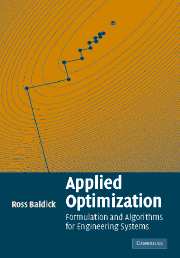Book contents
- Frontmatter
- Contents
- List of illustrations
- Preface
- 1 Introduction
- 2 Problems, algorithms, and solutions
- 3 Transformation of problems
- Part I Linear simultaneous equations
- Part II Non-linear simultaneous equations
- Part III Unconstrained optimization
- 9 Case studies
- 10 Algorithms
- 11 Solution of the case studies
- Part IV Equality-constrained optimization
- Part V Inequality-constrained optimization
- References
- Index
9 - Case studies
Published online by Cambridge University Press: 03 December 2009
- Frontmatter
- Contents
- List of illustrations
- Preface
- 1 Introduction
- 2 Problems, algorithms, and solutions
- 3 Transformation of problems
- Part I Linear simultaneous equations
- Part II Non-linear simultaneous equations
- Part III Unconstrained optimization
- 9 Case studies
- 10 Algorithms
- 11 Solution of the case studies
- Part IV Equality-constrained optimization
- Part V Inequality-constrained optimization
- References
- Index
Summary
In this chapter we will introduce two case studies:
multi-variate linear regression (Section 9.1), and
state estimation in an electric power system (Section 9.2).
Both problems will turn out to be unconstrained optimization problems of the special class of least-squares data fitting problems [84, chapter 13].
Multi-variate linear regression
Some of this section is based on [103] and further details can be found there. The development assumes a background in probability. See, for example, [31, 103].
Motivation
In many applications, we have a hypothesized functional relationship between variables. That is, we believe that there are some dependent variables that vary according to some function of some independent variables. The simplest relationship that we can imagine is a linear or affine relationship between the variables.
For example, we may be trying to estimate the circuit parameters of a black-box circuit by measuring the relationship between currents and voltages at the terminals of the circuit. We will have to try several values of current and voltage to characterize the circuit parameters. As in the circuit case study of Section 4.1, we could either:
apply vectors of current injections and measure voltages, interpreting the currents as the independent variables and the voltages as the dependent variables, or
apply vectors of voltages and measure currents, interpreting the voltages as the independent variables and the currents as the dependent variables.
- Type
- Chapter
- Information
- Applied OptimizationFormulation and Algorithms for Engineering Systems, pp. 363 - 380Publisher: Cambridge University PressPrint publication year: 2006

